Donatello and Michelozzo's marvelous pulpit for Prato Cathedral
Last year, on these pages, we had written about how the city of Prato is known, among other things, for the cult of the Sacred Girdle, or the belt that Our Lady allegedly gave to St. Thomas as proof of the Assumption into heaven. Or so it is believed. And we had told the story of this relic, considered miraculous, through the works of art preserved in the city. We had not, however, dwelt on the original pulpit that decorates the corner of the facade of Prato Cathedral: a whimsical and highly innovative work, created by Donatello (Florence, 1386 - 1466) and Michelozzo (Florence, 1396 - 1472), and designed specifically for the display of the Sacred Girdle. It is worth talking in a little more detail about one of the most interesting works of art of the Renaissance.
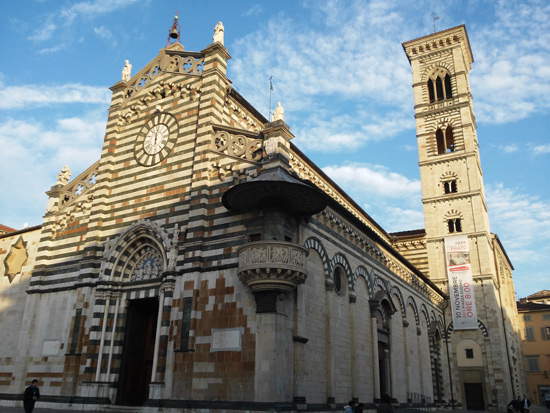 |
| The DUomo of Prato |
Let us begin by immediately clearing up any misunderstanding: the reliefs we see today lining the pulpit on the facade of the cathedral are copies. In fact, the originals are kept at the Museo dell’Opera del Duomo, housed in the bishop’s palace, which is right next to the cathedral-a small, quiet museum whose admission ticket also gives access to the cathedral’s monumental chapels. An entire room is dedicated to the pulpit by Donatello and Michelozzo, and the work has been here since 1970: in March of that year it had in fact been permanently dismantled for conservation reasons (the work, in the course of its history, has undergone several restorations) and replaced on the facade with the copy we observe today.
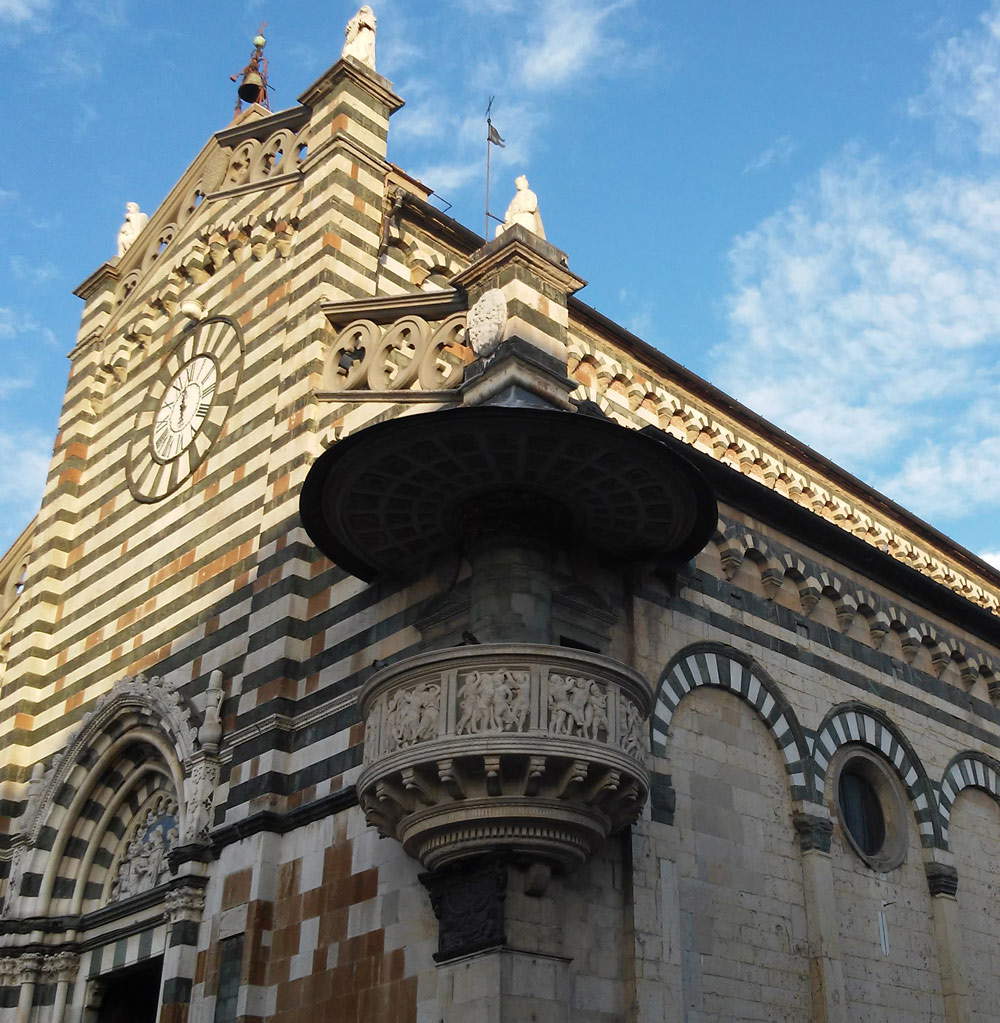 |
| Donatello and Michelozzo, Pulpit of Prato Cathedral (1428-1438; marble with mosaic background, 210 x 340 cm, relief slabs 73.5 cm x 79 cm; originals at the Museo dell’Opera del Duomo in Prato and copies on the facade of Prato Cathedral) |
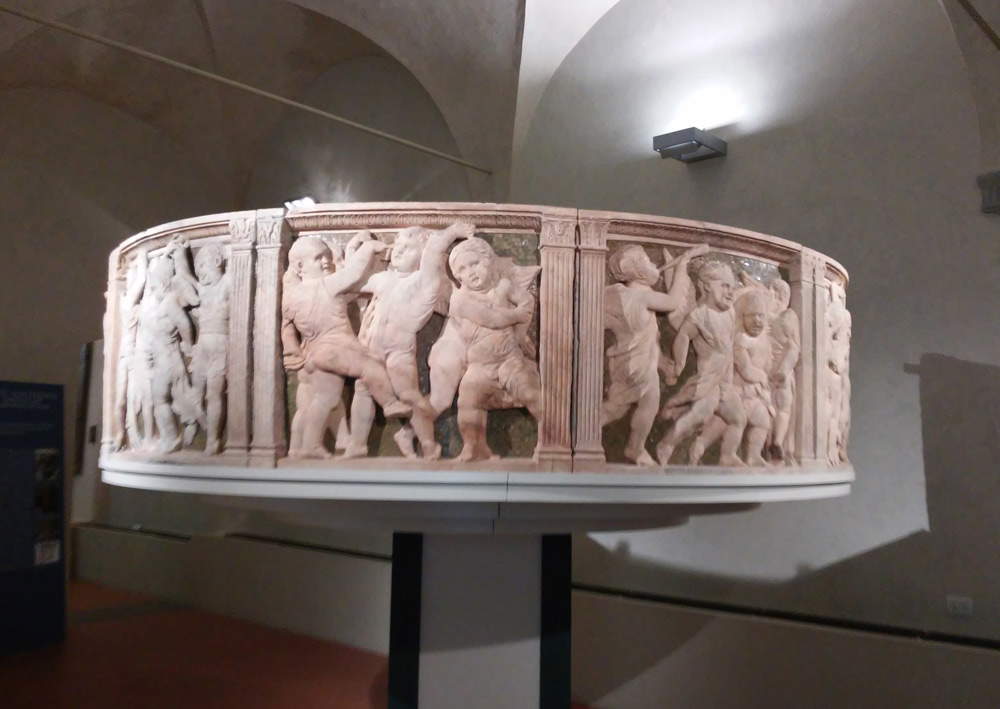 |
| The original reliefs at the Museo dell’Opera del Duomo di Prato |
The vicissitudes of the pulpit begin in 1428. A deed, bearing the date November 27, confirms for us the contract that the two great Florentine artists made in July with the Workers of the Chapel of the Girdle: Certa cosa essere si dicie, che dell’anno presente 1428 et del mese di luglio del detto anno, Lionardo di Tato, ser Lapo di messer Guido, Nicholao di Piero Benuzzi e Paolo di Donato, tutti da Prato, allora Operai della Cappella della Cintola di Nostra Donna posta nella pieve di Prato, together with certain other officers elected and deputized for the Comune of Prato [allogarono] to Donato di Nicholò et Michele di Barttolomeo, Florentine citizen carvers, to make a certain pergamo in the said pieve, at those times and terms and chon patti modi e conditioni containing ec., and of which it is said to appear by the hand of Ser Iacopo da Colle then chancellors of the Commune of Prato. The deed, countersigned by the artists, binds them to return any sum advanced by the Workmen if there are delays or defaults with respect to the original contract. The problem (for the Chapel Workers, of course) is that Donatello and Michelozzo, being artists of great renown, are overworked and have a lot of commitments. As a result, the work is expected to go on for a long time, and evidently with the act of November 1428 the Workmen wanted to guard themselves in some way against any annoyances that might arise from the fact that entrusting a job to Donatello and Michelozzo might mean running the risk of prolonged breaks that the two artists might take to finish other work. And the Workers reasoned well, for the work would go on for a decade or so. Suffice it to say that, despite the fact that the contractual timeframe called for the work to be completed within thirteen and a half months (thus by September 1429), the first marbles did not arrive in Prato until December 1429. And in any case this is not enough to get the work underway, because Donatello is busy in Rome attending to some work in the capital of the Papal States.
As a matter of fact, the works succeed in starting only in 1433, and even the intervention of Cosimo il Vecchio is necessary to unblock the situation. In fact, one of the Chapel’s Workers, a certain Cambio di Ferro, turned to him in September 1432: the Medici agent thus urged the return of Donatello and Michelozzo, but another three months passed before they all decided to return to Prato to begin work on the pulpit. In the spring of 1433 payments to the two artists resumed, new marbles arrived from Carrara, and, beginning in May, work could proceed a little more expeditiously: during the summer of 1433, therefore, the old pulpit was removed and the artists began work on the slabs that were to cover the structure. In the meantime, Michelozzo took over the direction of the work, which in the period of his and Donatello’s absence had passed to Pagno di Lapo Portigiani (Fiesole, 1408-after 1469): the young Fiesole sculptor had had to maintain good relations with the Workmen, and before Donatello and Michelozzo returned he had done his best to get some of the material needed to start the work again to Prato. Indeed, critics have speculated that work had not stopped during the absence of the two great sculptors: indeed, it is highly plausible that by the time they returned from Rome the architectural structure of the pulpit, designed by Michelozzo, had already been completed. And this may explain why it was precisely between late 1432 and early 1433 that the Workers became so insistent in clamoring (even with the help of the Medici) for the return of the two.
In fact, the only part of the pulpit that is completed in 1433 is, most presumably, the bronze capital that is supposed to enable the entire structure to stand on the corner pillar of the facade of the Duomo. The work, designed by Donatello and cast by Michelozzo and Maso di Bartolomeo (Capannole di Bucine, 1406 Dubrovnik, c. 1456) offers us what is to all intents and purposes a very fresh reminder of the Roman journey. Indeed, the work presents itself to our view with some rich floral and plant motifs that recall those that decorated Corinthian capitals, especially those of the Hadrianic age, and are accompanied by two reclining putti (they almost assume the typical pose of statues that represented river gods). The larger festoon is supported at either end of the capital by two standing genets (we also see others, smaller ones, fluttering among the flowers), while an additional putto crowns the entire composition by leaning out on this side of a sort of balustrade that Donatello places at the top of the capital. Like the panels, the original capital is also kept in the Museo dell’Opera del Duomo, since 2011 to be exact: having completed the restoration work that had affected it, it too was in fact replaced by a copy.
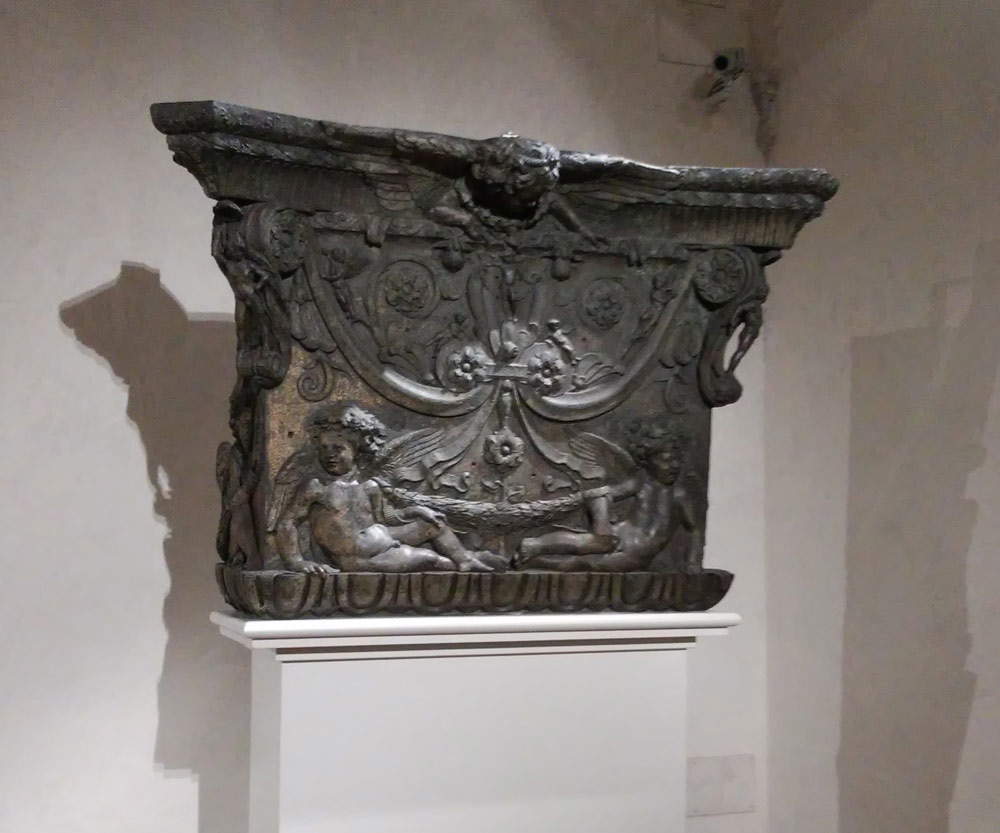 |
| Donatello and Michelozzo, Capitello per il pulpito del Duomo di Prato (1433; cast bronze partially gilded, finished with burin and chisel, 96.8 x 144.2 x 50.6 cm; Prato, Museo dell’Opera del Duomo) |
On May 27, 1434, with the signing of a new contract, the pulpit was finally in the home stretch, although it would take another four years to complete: it would be mounted on the facade of the Duomo in the summer of 1438, and the Sacred Girdle would finally be displayed from the new pulpit, for the first time, on September 8. The new document concerns the reliefs that decorate the parapet of the Prato pulpit. They are divided into seven panels and depict a procession of dancing and festive putti, the invention of which is the brainchild of Donatello, moreover the only signatory to the new contract. The seven panels are separated from each other by pairs of fluted pillars with Corinthian capitals, while the background is covered with golden mosaics that, by reflecting the light, give brightness to the dance of the putti, making it even more lively and cheerful. However, we do not know if this last intervention was Donatello’s idea, because contemporary sources do not mention it. Or rather: we know that the background was originally intended to be occupied by a mosaic, but no document speaks of any gilding of the tesserae such as we can observe today decorating the panels.
The putti assume a wide variety of poses: they dance, run, wiggle, hold hands, turn away from each other, entwine their bodies, we even have some playing musical instruments (two have a trumpet and one plays a tambourine). The composition is in the spirit of rhythm andharmony: each panel hosts, without exception, five putti that give life to a celebration that is indeed frenetic but is nonetheless balanced, without any characters taking uncomfortable or ungainly poses. However, the artist, in each slab, experiments with different solutions: the first panel, probably the least dynamic of the whole, has the putti all looking in the same direction (except for one who is looking toward us) and arranged neatly in a row, one behind the other, with the second and fourth leaning slightly out. As a result, the panel appears more crowded than others, such as the fifth: here, Donatello has chosen to hide two putti behind as many of their companions (of the one in the second foreground on the left we can barely make out an eye and a lock of hair, while the one on the right has his face completely hidden by the putto in front of him), making the composition more airy.
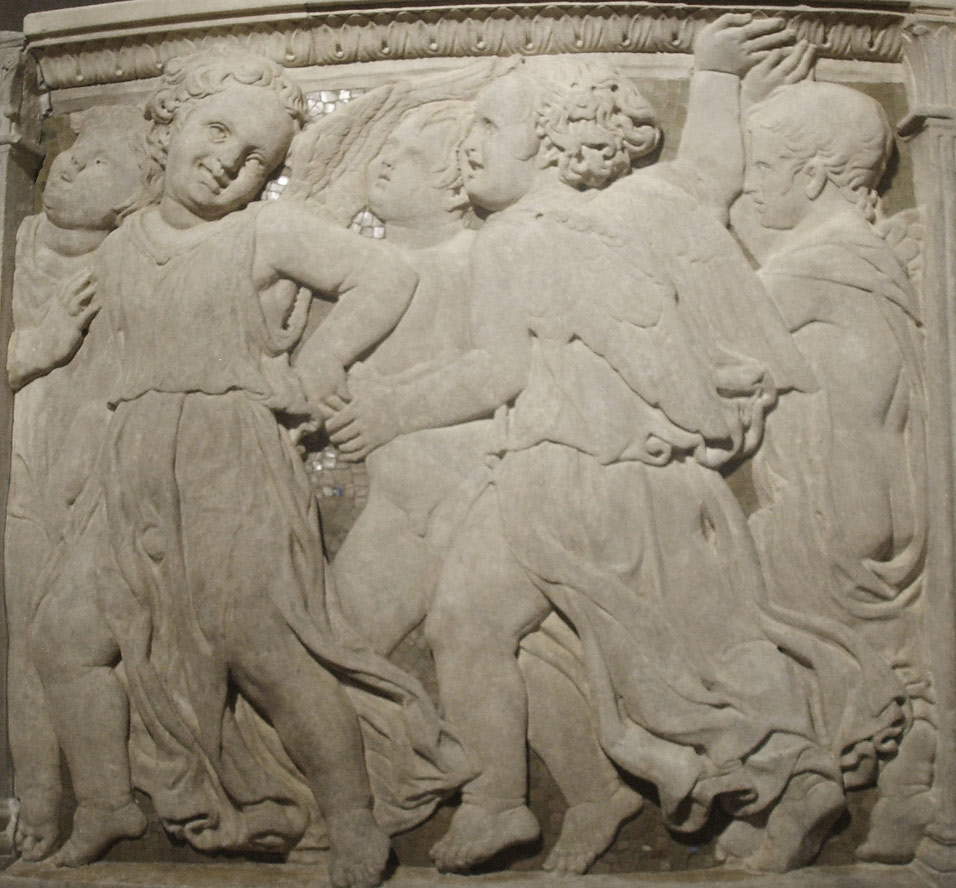 |
| First panel. Credit |
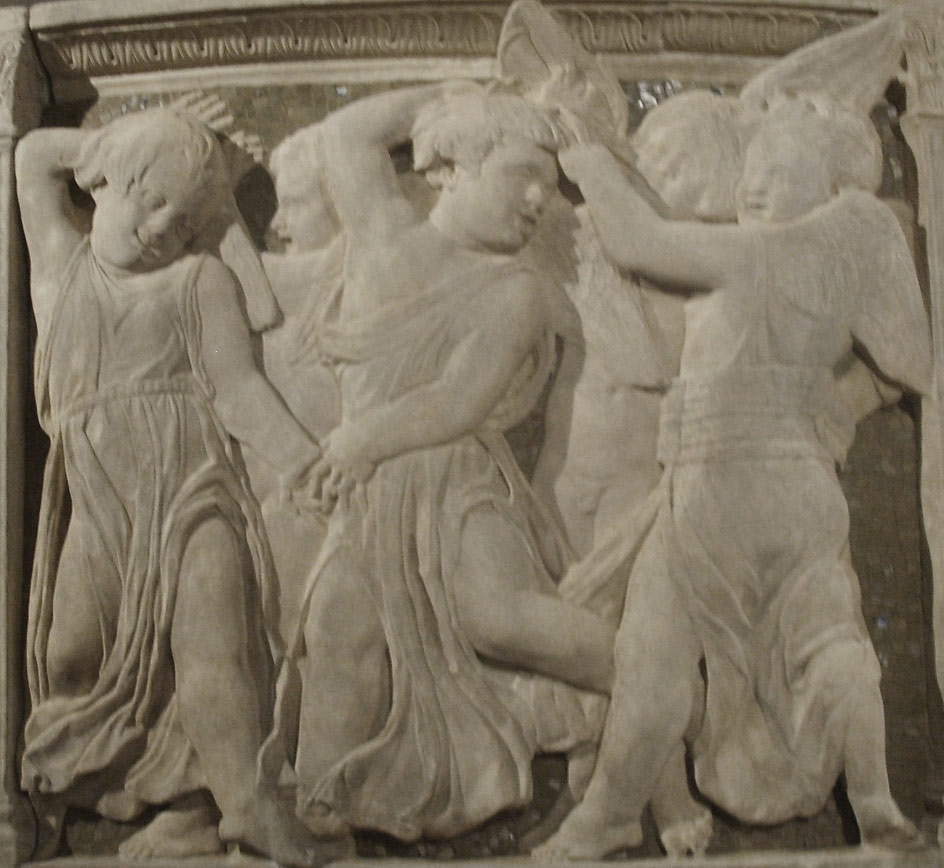 |
| Second panel. Credit |
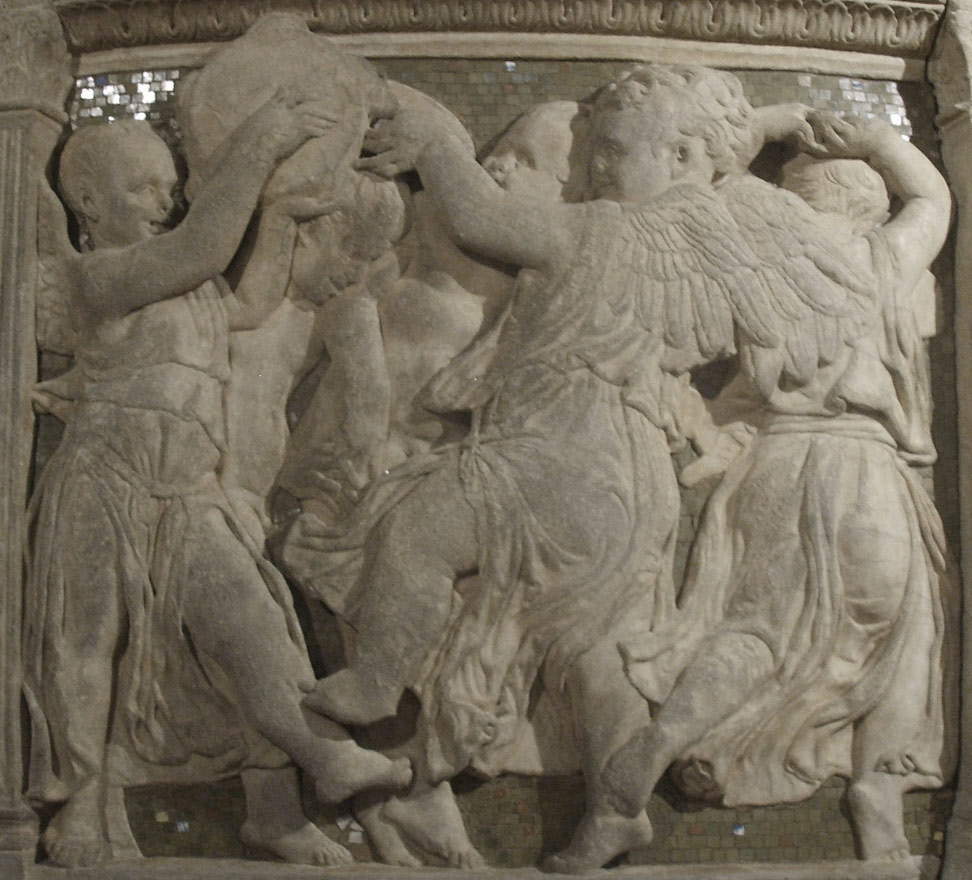 |
| Third panel. Credit |
 |
| Fourth panel (middle panel). Credit |
The central relief seems to be the one of the highest quality, both in terms of invention and achievement, so much so that it is thought to have been sculpted by Donatello himself (in fact, it is not taken for granted that the great artist made all seven panels himself: workshop assistants also participated in the undertaking). Donatello, here, made a very balanced and harmonious scheme, creating two symmetries, one between the putti at the ends (both in contrapposto, that is, the pose with the leg that supports the weight advanced and the other that instead follows) and the other between those in the center which, also in contrapposto, meet brushing against each other and almost completely hiding the fifth putto, which occupies the exact center of the composition. The scheme is somewhat similar to that of the last panel (which is, however, the first to have been executed): the putti at the extremities here assist, again positioned symmetrically, the dance of the two central ones who move following the same rhythm, observed by the fifth putto, also, as in the middle relief, in the exact center of the scene balancing the whole composition. This panel, too, is considered by critics, for its quality of execution and originality of invention, to be entirely Donatello’s autograph work. Finally, the third panel (beginning the count from the north side of the pulpit) is also added to the group of entirely Donatellian panels, in all probability.
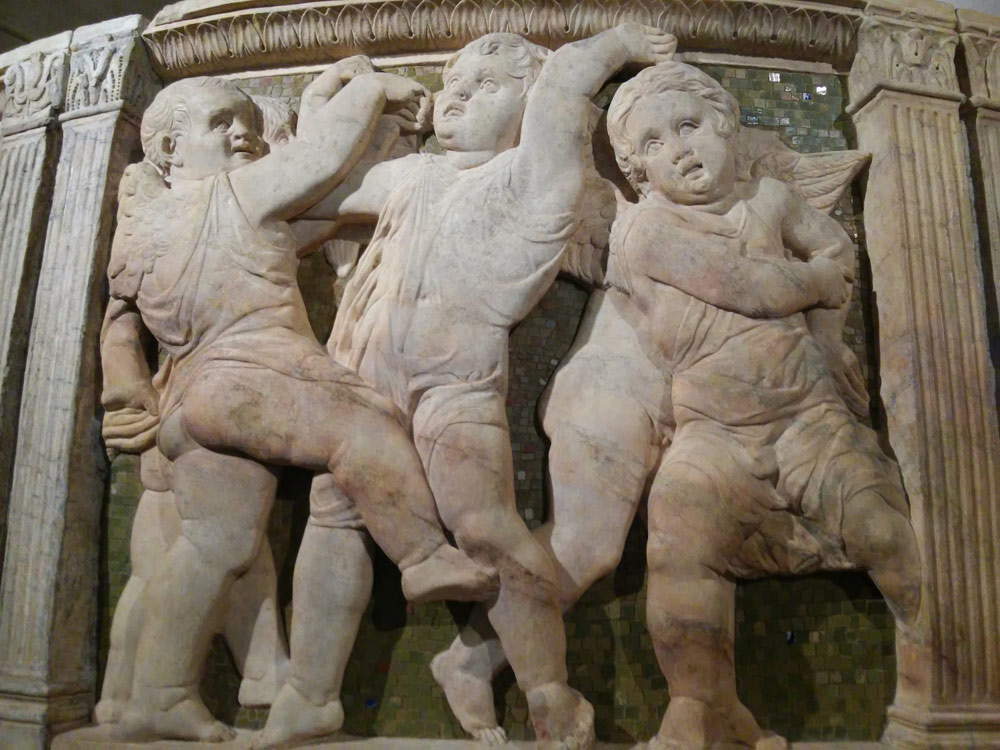 |
| Fifth panel |
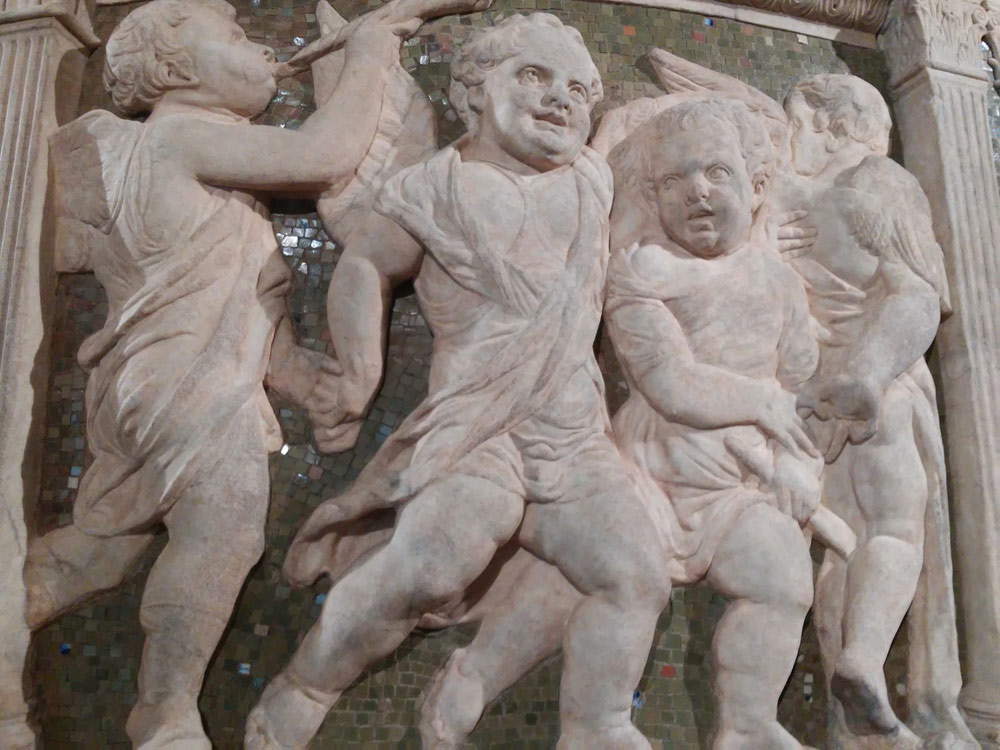 |
| Sixth panel. |
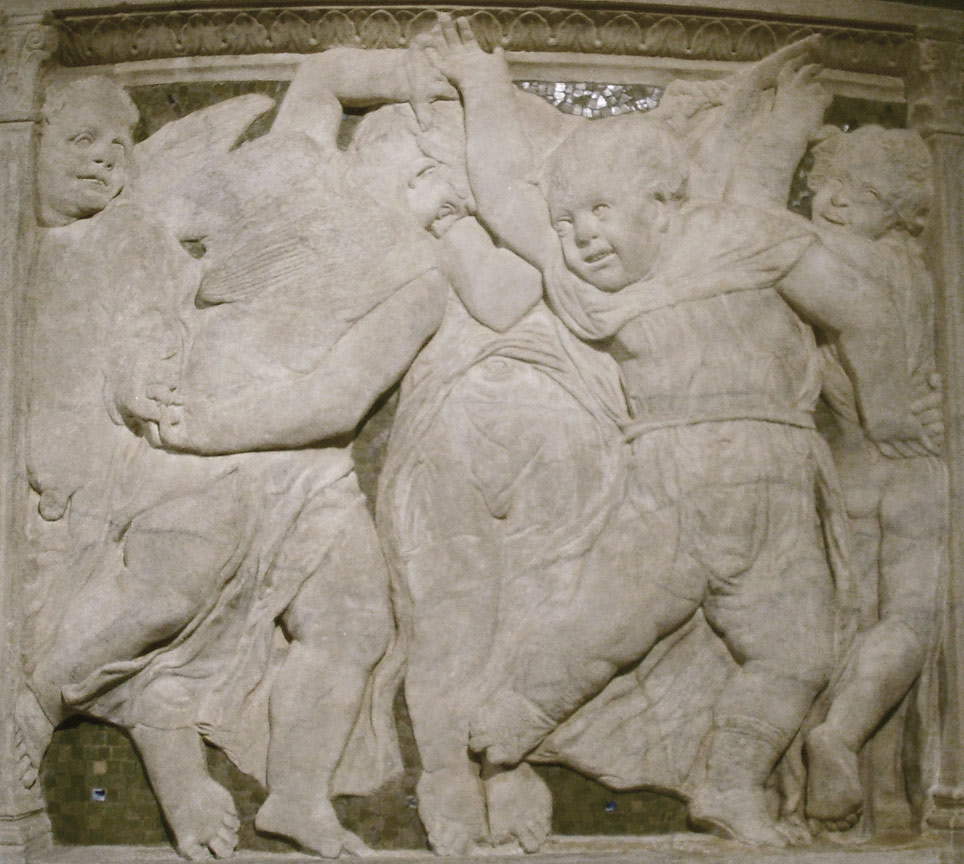 |
| Seventh panel. Credit |
For his putti, Donatello was probably inspired by a Roman sarcophagus he had seen in Pisa during his stay in the city in 1426: it is a sarcophagus still preserved today at the Camposanto (in Piazza dei Miracoli). This ancient work, from the end of the second century AD, is decorated with a series of putti indulging, intoxicated, in the pleasures of the Dionysian rite they are celebrating. Although the putti of the Prato pulpit are not the first in Donatello’s production (they are preceded, by a few years, by the bronze ones made for the Baptistery of San Giovanni in Siena), the fortunate iconography of the dance, which is tackled here by Donatello for the first time in his career (as well as for the first time in the entire Renaissance), would succeed in achieving considerable success.
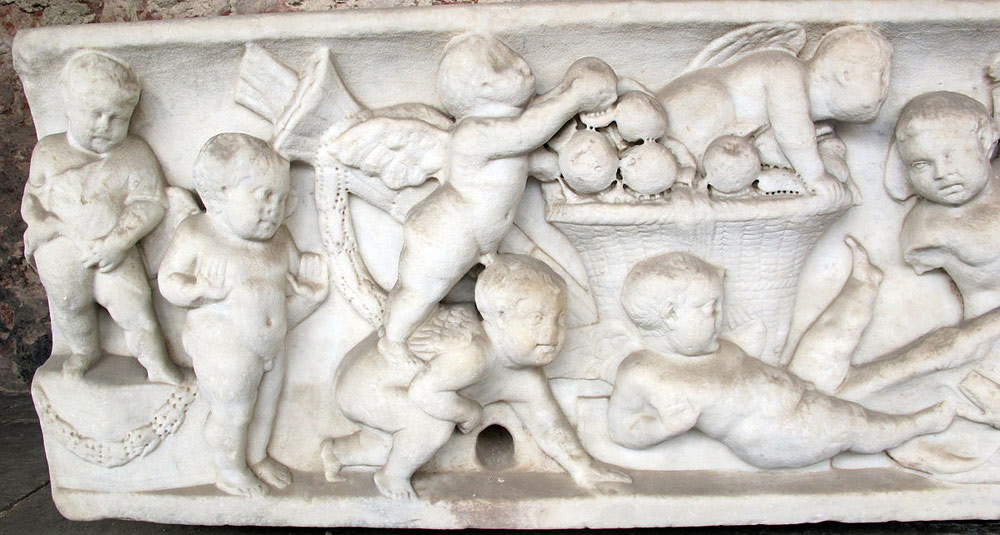 |
| Sarcophagus with drunken putti (3rd cent. AD; Marble; Pisa, Camposanto monumentale). Credit |
At this point, one might wonder why Donatello chose to resort to a classical subject for a monument destined for a Christian temple (although this is not the first case, in the 15th century: the primacy perhaps belongs to Jacopo della Quercia, in all probability the first 15th-century sculptor to decorate a sarcophagus, namely that of Ilaria del Carretto, with putti that, in his case, hold festoons). Indeed, if the “putto-angel” association of ideas might seem easier for the sculptures adorning the Sienese baptismal font, the links between the Christian religion and the Prato putti, which, moreover, are not winged like those in Siena, appear more tenuous. In ancient times, putti decorated the sarcophagi of men held up as examples of virtue since, in ancient Dionysian cults, putti were believed to inhabit the paradise of Dionysus, and we not infrequently see them, in Roman monuments, intent on harvesting grapes: wine, which comes from grapes, becomes a symbol of rebirth (the one to which the hero aspires in the afterlife). These iconological aspects are literally transferred into the Christian imagination, and the figure of the putto is thus associated with the Christian concept of salvation, in direct connection with the motif of the wine poured by Christ at the Last Supper and a symbol of his blood (even in antiquity, wine was considered somewhat like the “blood” of grapes), thus of his sacrifice to redeem humanity. The fact remains, however, that Donatello’s pulpit is considered by critics (De Fusco, Argan), like the Florentine chancel, to be the most Dionysian work of 15th-century Italy. And it would be limiting to underestimate the importance of the classical component of Donatello’s work by justifying the putti on the sole basis of connections with the Christian religion: the Dionysian dynamism, a mirror of that “innate Donatellian paganism” of which the art critic Guido Edoardo Mottini had spoken, is one of the most obvious manifestations of the “revolution” that the sculptor operated in the art of the 15th century, which began with the total and deeply felt recovery of classical art.
Perhaps it is also because of the similar way of approaching the ancient that the pulpit of Prato Cathedral so fascinated the young Gabriele D’Annunzio, who, as is well known, spent his youth in the Tuscan city, and in a letter wrote some memorable impressions of Donatello’s work: “Prato is [...] illuminated by the sky less than by a marble pulpit sculpted in low relief divinely by the divine Donatello. This pulpit is in the open air, at an outer corner of the Duomo; and it represents a dance of putti. It is a famous work by the Florentine sculptor. The image that has remained most deeply impressed in my memory, of that whole period of my life, is precisely the image of that marvelous pulpit.”
Reference bibliography
- Anna Maria Giusti, Donatello restored: the marbles of the Prato pulpit, Maschietto Editore, 2000
- Arthur Rosenauer, Donatello. The Complete Works, Mondadori Electa, 1997
- Aldo Capobianco, La Sacra Cintola nel Duomo di Prato, Martini Editore, 1995
- Clarice Innocenti, Il pulpito di Donatello del Duomo di Prato: una ricerca storico artistica sullo stato di conservazione in OPD Restauro, no. 6, 1994, pp. 41-48
- Francesco Guerrieri, Donatello and Michelozzo in the Prato pulpit, Edam, 1970
Warning: the translation into English of the original Italian article was created using automatic tools. We undertake to review all articles, but we do not guarantee the total absence of inaccuracies in the translation due to the program. You can find the original by clicking on the ITA button. If you find any mistake,please contact us.




























